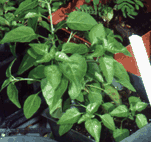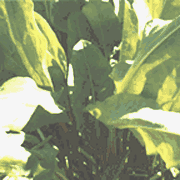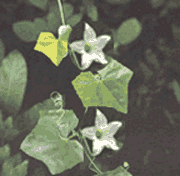Many herbs and spices used in Thai cuisine have beneficial medicinal properties. Herewith are some examples.
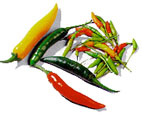 |
Chilli: "Phrik" in Thai Chilli is an erect, branched, shrub-like herb with fruits used as garnishing and flavouring in Thai dishes. There are many different species. All contain capsaicin, a biologically active ingredient beneficial to the respiratory system, blood pressure and heart. Other therapeutic uses include being a stomachic, carminative and antiflatulence agent, and digestant. |
 |
Cumin: "Yi-ra" in Thai Cumin is a small shrubbery herb, the fruit of which contains a 2-4% volatile oil with a pungent odour, and which is used as a flavouring and condiment. Cumin's therapeutic properties manifest as a stomachic, bitter tonic, carminative, stimulant and astringent. |
 |
Garlic: "Kra-thiam" in Thai Garlic is an annual herbaceous plant with underground bulbs comprising several cloves. Dried mature bulbs are used as a flavouring and condiment in Thai cuisine. The bulbs contain a 0.1-0.36% garlic oil and organic sulfur compounds. Therapeutic uses are as an antimicrobial, diaphoretic, diuretic, expectorant, antiflatulence and cholesterol lowering agents. |
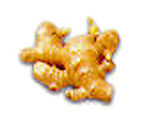 |
Ginger: "Khing" in Thai Ginger is an erect plant with thickened, fleshy and aromatic rhizomes. Used in different forms as a food, flavouring and spice. Ginger's rhizomes contain a 1-2% volatile oil. Ginger's therapeutic uses are as a carminative, antinauseant and antiflatulence agent. |
 |
Galanga: "Kha" in Thai Greater Galanga is an erect annual plant with aromatic, ginger-like rhizomes, and commonly used in Thai cooking as a flavouring. The approximately 0.04 volatile oil content has therapeutic uses as carminative, stomachic, antirheumatic and antimicrobial agents. |
 |
Hoary Basil: "Maeng-lak" in Thai Hoary Basil is an annual herbaceous plant with slightly hairy and pale green leaves, eaten either raw or used as a flavouring, and containing approximately 0.7% volatile oil. Therapeutic benefits include the alleviation of cough symptoms, and as diaphoretic and carminative agents. |
 |
Kafffir: "Ma-krut" in Thai The leaves, peel and juice of the Kaffir Lime are used as a flavouring in Thai cuisine. The leaves and peel contain a volatile oil. The major therapeutic benefit of the juice is as an appetiser. |
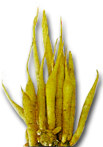 |
(No Common English Name): Krachai inThai This erect annual plant with aromatic rhizomes and yellow-brown roots, is used as a flavouring. The rhizomes contain approximately 0.8% volatile oil. The plant has stomachache relieving and antimicrobial properties, and therapeutic benefits as an antitussive and antiflatulence agent. |
 |
Lemon Grass: "Ta-khrai" in Thai This erect annual plant resembles a coarse grey-green grass. Fresh leaves and grass are used as flavouring. Lemongrass contains a 0.2-0.4 volatile oil. Therapeutic properties are as a diurectic, emmanagogue, antiflatulence, antiflu and antimicrobial agent. |
 |
Lime: "Ma-nao" in Thai Lime is used principally as a garnish for fish and meat dishes. The fruit contains Hesperidin and Naringin , scientifically proven antiinflammatory flavonoids. Lime juice is used as an appetiser, and has antitussive, antiflu, stomachic and antiscorbutic properties. |
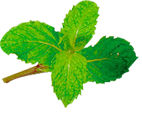 |
Marsh Mint: "Sa-ra-nae" in Thai The fresh leaves of this herbaceous plant are used as a flavouring and eaten raw in Thai cuisine. Volatile oil contents give the plant several therapeutic uses, including carminative, mild antiseptic, local anaesthetic, diaphoretic and digestant properties. |
 |
Pepper: "Phrik-Thai" in Thai Pepper is a branching, perennial climbing plant from whose fruiting spikes both white and black pepper are obtained. Used as a spice and condiment, pepper contains a 2-4% volatile oil. Therapeutic uses are as carminative, antipyretic, diaphoretic and diuretic agents. |
 |
Sacred Basil: "Ka-phrao" in Thai Sacred Basil is an annual herbaceous plant that resembles Sweet Basil but has narrower and often times reddish-purple leaves. The fresh leaves, which are used as a flavouring, contain approximately 0.5% volatile oil, which exhibits antimicrobial activity, specifically as a carminative, diaphoretic, expectorant and stomachic. |
 |
Shallot: "Hom,Hom-lek,Hom-daeng"in Thai Shallots, or small red onions, are annual herbaceous plants. Underground bulbs comprise garlic-like cloves. Shallot bulbs contain a volatile oil, and are used as flavouring or seasoning agents. Therapeutic properties include the alleviation of stomach discomfort, and as an antihelmintic, antidiarrhoeal, expectorant, antitussive, diuretic and antiflu agents. |
 |
Sweet Basil: "Ho-ra-pha" in Thai Sweet Basil is an annual herbaceous plant, the fresh leaves of which are either eaten raw or used as a flavouring in Thai cooking. Volatile oil content varies according to different varieties. Therapeutic properties are as carminative, diaphoretic, expectorant, digestant and stomachic agents. |

|
Turmeric: "Kha-min" in Thai Turmeric is a member of the ginger family, and provides yellow colouring for Thai food. The rhizomes contain a 3-4% volatile oil with unique aromatic characteristics. Turmeric's therapeutic properties manifest as a carminative, antiflatulence and stomachic. |




